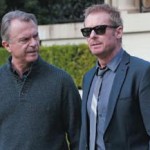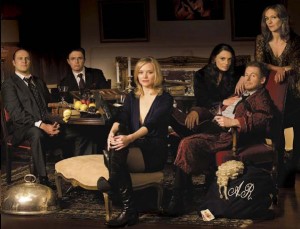On Location: Rake
 Encore visited the set of the new Australian legal drama Rake. Producer Ian Collie and director Peter Duncan spoke to Aravind Balasubramaniam about the public fascination behind the legal profession and how their show aims to de-mystify the trade.
Encore visited the set of the new Australian legal drama Rake. Producer Ian Collie and director Peter Duncan spoke to Aravind Balasubramaniam about the public fascination behind the legal profession and how their show aims to de-mystify the trade.
Lawyers are popular on television, and the court room has been so glamourised that audiences have a certain fascination for legal stories. According to Collie, of Essential Viewing Group, “Sometimes it is good to prick that fantasy.”
The story is the brainchild of Richard Roxburgh-who plays the lead character-co-writer and director Peter Duncan, and real life barrister Charles Waterstreet. Together they work shopped the idea of the protagonist Cleaver Greene; a brilliant, iconoclastic and self destructive criminal barrister with an affection for cases that are unwinnable and beyond bizarre.
“He is a rake, a classic Lothario who manages to professionally get his life together and is the compassionate defender of life’s losers”, said Collie. “He’s always in debt, he’s got a past of cocaine addiction and is bit of a womanizer. He’s a classic bachelor, but he’s still warm and likable. You can’t help but love him; if it was another actor who didn’t have Richard’s charisma, there would have been the risk of the character being self indulgent.”
Rake was initially created as a telemovie – in the typical BBC format, with one film to be released every year. The show was originally taken to Foxtel, but nothing came through. The ABC then surfaced as another option; the potency of the script and depth of the characters proved a success when pitched to the public broadcaster, who liked everything except one detail: Rake should be an hour long series instead of a telemovie.
“This was an interesting character and a number of things could be told about him, so it would be good to expand the canvas of his life in this way” admitted Peter Duncan, who was resistant to the idea at first.
Each episode will present a court case and the personal storylines of the five main characters serve as the main narrative for eight episodes. “It was at first commissioned as six hour long episodes, but the ABC liked it so much they wanted us to do eight, Actually they wanted us to do 10!
So in the end, we agreed to do eight and we literally just finished the last two scripts as we were shooting episodes five and six”, added Collie.
It wasn’t a budgetary issue, the ABC would have provided the additional funds to make produce 10 episodes. The problem was time. “I’m wearing three hats, I am the producer, director and a writer, and I’m trying to make sure the creative side of the show, keeps afloat. It just would have been too hard to go into post production with so much to do. It was the right decision in the end, I just didn’t have the time to do it”, said Duncan.
Producing and writing a show demands different skills to approach especially when considering the fast paced nature of a TV series.
“It’s been wonderful working with Andrew Knight; we’re old friends and we’ve been wanting to work together on something for a long time. It’s just absolutely invaluable having him on board. Still, as he warned me, as he is such an experienced series television producer writer and director himself, it’s like herding the cats: writing scripts is very hard. You are looking at 400 minutes of drama, and getting all those scripts to haze is a tough job”.
Duncan has made four features yet this is his first TV series, which required readjustment for the experienced producer: “It’s a very different world,” said Duncan, who co-wrote the series with screenwriter Andrew Knight. “The process is somewhat neverending; even when we are shooting a block, we are still making changes to the script, so there can be a curb during the course of the shoot.
“You don’t get the time that you do on a set, particularly in the cutting room. The shooting schedule is bearable but in the cutting room it’s so fast you don’t get breathing space, The up side of that is, it’s really energising and exciting, because you have to keep making decisions and stand by them, live and die by them”, added Duncan.
A quality set of scripts coupled with a locally produced, but internationally known cast – with guest performances from the likes of Hugo Weaving and Sam Neill – crucial to fund the $7.3m series. Rake received a very good advance from U.K distributors, DCD productions.
“There was a lot of interest from U.K distributors, in contrast to documentaries that got around $10,000 to $20,000. Here you get substantial advances to the point where there were three to four individuals who kept increasing their offer!”. Due to fluctuations in the currency exchange market, it was wise to receive the funding in Australian Dollars, which kept increasing their value.
“I also said I wanted some of the money to be cash flowed straight away through to production, and they were all fine with it” added Collie.
A LEGAL SENSE OF HUMOUR
 Many shows have populated the courtroom drama genre, but nearly 90 percent of them portray the legal field as an extension of a core police investigation. So what makes Rake stand out distinctly in the courtroom drama genre?
Many shows have populated the courtroom drama genre, but nearly 90 percent of them portray the legal field as an extension of a core police investigation. So what makes Rake stand out distinctly in the courtroom drama genre?
“The tone is sort of wry but not satirical, it’s character based comedy, it’s reasonably smart, we wanted to give it an edge that represented Sydney in a way. If you look at it, Sydney is like a very expensive hooker, very beautiful to look at on the outside, but what lies within could be anything. So there is an edge to this about challenging perceptions, in a very comical way.“ commented Duncan.
In Rake, the defendants are guilty from the start; there’s no question about whether they did it or not. It’s all about the process.
According to Collie, there haven’t been many courtroom dramas in Australia: “Rake aims to satirise the legal profession like Boston Legal, but our humor is bit more subtle than American humor. That is the absurdist element”.
The show was shot in and around Sydney and therefore the city became another character. On one side lies its charm, beauty and glitz and on the other, its seedy underbelly; a classic duality between light and darkness. Much of the footage was shot on Sony F23 cameras on the recommendation of Director of photography, Bob Humphreys.
“It is expensive. We wanted to have good production value on screen, we didn’t want it to be like a sitcom with one or two places, so there are a number of location moves, we are moving all around Sydney and taking a crew of this size with all the extras…it does get expensive”, commented Collie.
Some of the shoot locations include the district courts at Taylor Square, Sydney. “It is a real credit to the attorney general’s office” said Collie, “We are really fortunate to use it”. The barrister chambers and law firm interiors were filmed in the converted rooms of the old Sydney Law School.
“I’d like to see how the legal profession respond to it, most lawyers have a good sense of humor” added Collie.
Rake starts November 4 at 8:30pm, on ABC.




Would like to read the script to savor the dialogue, though the acting of Roxburgh is superb
User ID not verified.